Welz Victorian Style Production
What Did They Produce.... and When?
by Craig Orkney
For several years I have been researching the production of Franz Welz Klostergrab, a little understood, and even less documented Bohemian/Czech Firm. The majority of my research findings focused on what ended up being their interwar production, falling between WWI and WWII. Although we know of U.S. Customs records indicating import of their production into the United States, United Kingdom, and Australia as early as 1885, I believe that their most productive period was interwar production which appears to have been imported in large quantities by the Butler Brothers, a large U.S. wholesaler.
During this same period, I have also studied a type of glass I suspected to be Welz because of some similarities to their interwar production, but never really focused on it as intently as the Deco style décors. This style of glass is what I would refer to as “Victorian” in design and feel. I do not believe that all of it is that early though. I now believe that a portion of it was produced just prior to WWI to appeal to a specific market.
Amongst these have been a couple of décors in both a spatter style, and also a décor I now refer to as Harlequin Honeycomb. It appears to be an earlier variant of the Honeycomb décor found in the interwar production by Welz. The interwar production is most commonly found in a bright pink, a green with some mica content, and also a blue.
Images from a well received Tango exhibit in 2012 in the Czech Republic, along with some images forwarded to me by a collector in Germany of some Welz examples in the museum in Navy Bor, have now provided me some important shapes with which I can now link this décor I have long suspected to be Welz, to the company and their production. Through these shapes it also becomes quite obvious that there are also several spatter style décors we can link to Welz.
In Das Böhmische Glas, published by the Glasmuseum Passau, Welz is categorized as a firm with minor output during the Art Nouvea era, but a company who strived to differentiate their production from other houses by pursuing an artistically unique style. Their interwar production also seems to hold true to this mission.
This article is the result of an ongoing line of research over a period of a couple of years, and I am pleased to now be able to confirm and publish at least a portion of what I have suspected for several years now.
So where do we start?
I guess a reasonable place to start would be with some of the examples shown in the 2012 Tango Exhibit, and also a piece in the Novy Bor museum on display as Welz. So let’s start with the Tango Exhibit. The picture directly below is an image of a Welz case at one of the Exhibit stops. The Welz examples are on the left side and include the black, red and yellow covered piece in the center. This case does not show all of the examples displayed as Welz in the exhibit, just part of a single case. The lower image is simply an enlargement of the two front left trophy vases. Those two particular shapes are important to this article.
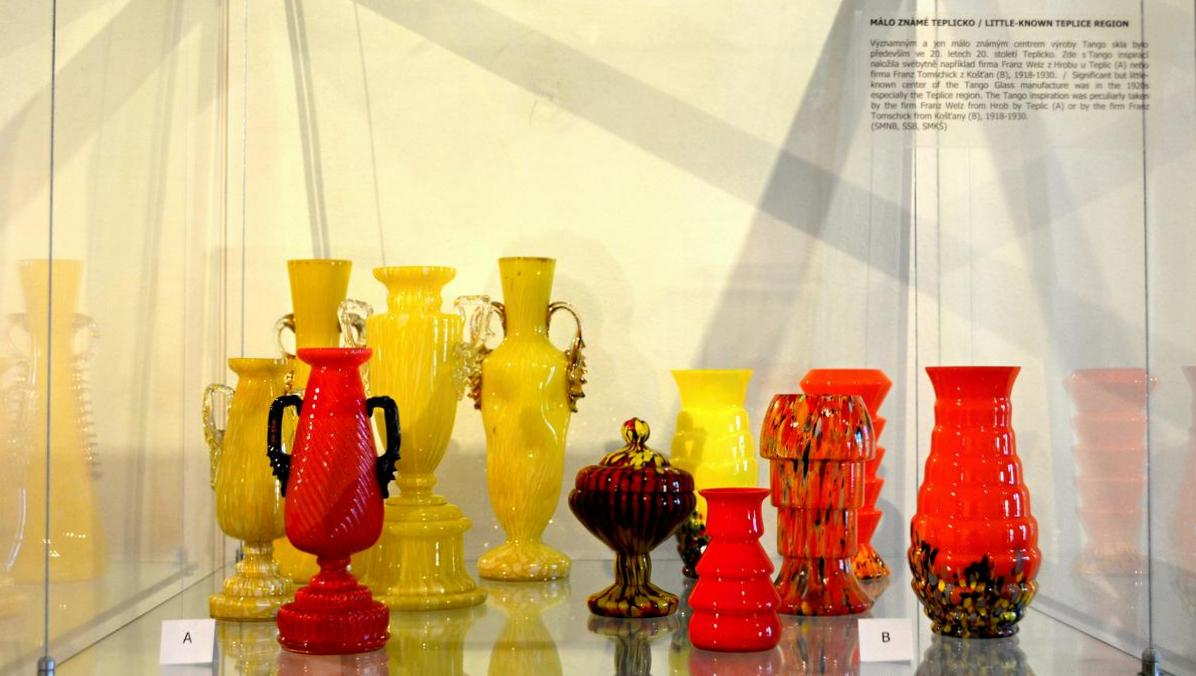
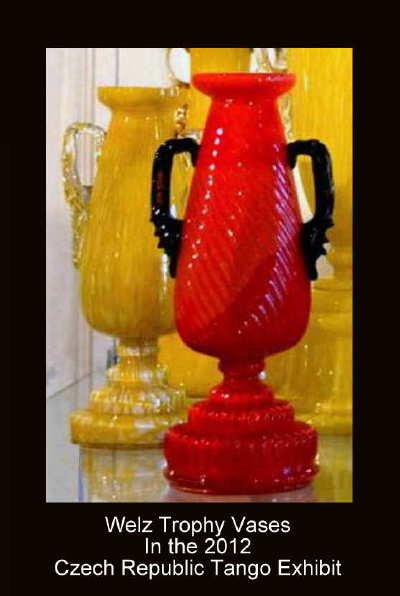
So here we have two quite similar, yet different examples of trophy vases from Welz. The black and red version can be found with a “Made in Czechoslovakia” provenance stamp on the base indicating post 1918 production of the shape. I have not yet found an example of the yellow variegated décor with the same stamp. It is quite possible that these two examples represent both pre and post WWI production. So with what do these two examples provide us? In my opinion they provide us with a couple of examples of unique shapes, not seen all that frequently, with which we can start to examine some décor links if they exist.
I would have to interject at this point that I have been studying trophy vases and their shapes for quite some time, and there are a wide variety of shapes which I believe to be Bohemian. So although there are many different trophy vase forms, the two I am starting with here are not all that commonly seen.
So let’s take a look at what this unique and fairly uncommon shape can show us. Let’s start with the ribbed version, known to have been produced interwar. The image below shows examples which are in the same ribbed form in different décors. The shape is Welz, so it would follow that the décors on the examples are also Welz. The 5th image in this group is an image from "Glass Collector's Digest" December / January 1999, Volume XII, Number 4. The article is by John Franks and the image can be located on Page 53 and shown in figure 8. These images are used with the permission of both John Franks and Dave Richardson, the publisher of the "Glass Collector's Digest".
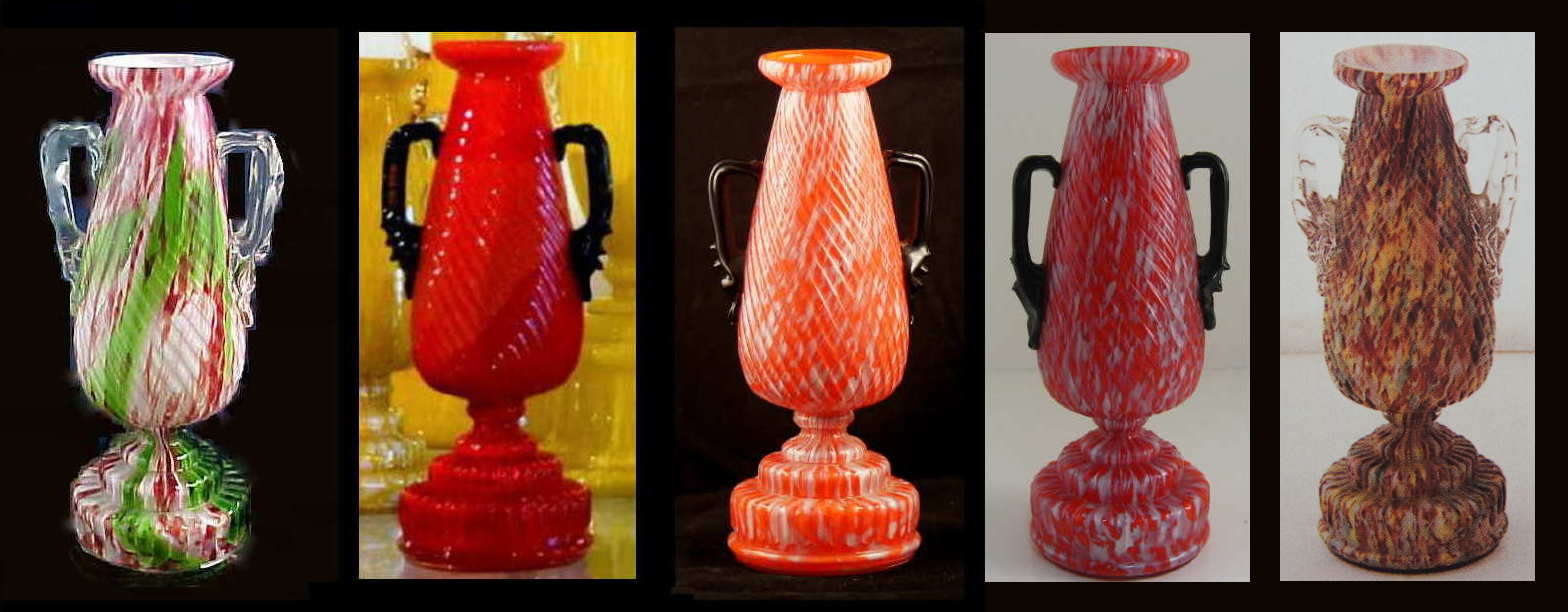
Now let’s look at the other smooth bodied Trophy vase from the Tango Exhibit. The image below shows that same basic shape in not only the décor as seen in the exhibit, but also some other distinct décors. Again, my belief is that the décors found on this shape would also be Welz décors. So it is here that we find a starting point to take a serious look at some other possibilities of Welz production.
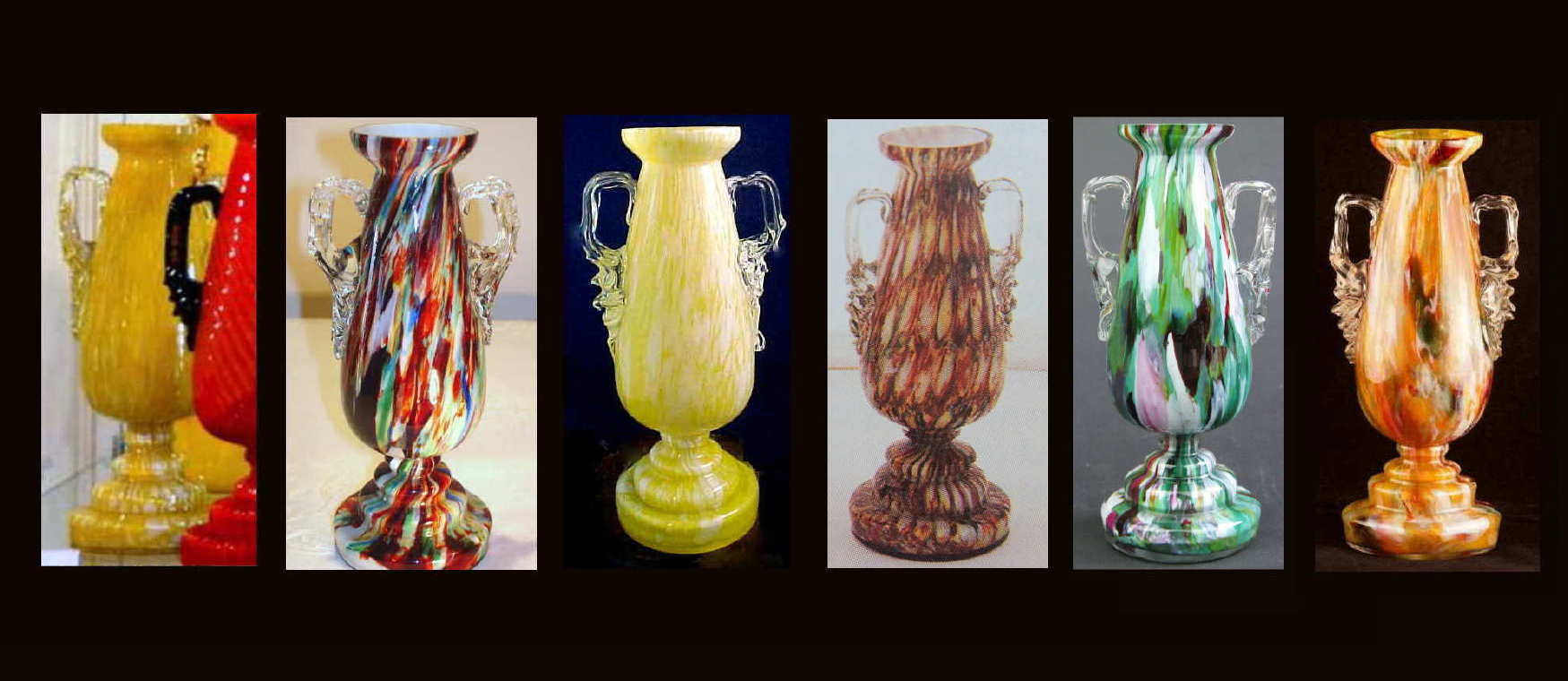
So let’s take a look at the last 2 décors in this group. Although some spatter décors are difficult to differentiate, this is a fairly unique décor in an unusual combination of colors. One of the characteristics of this décor is that is contains an inner color which is a kind of orange/yellow, which glows orange when exposed to UV light. This is generally an indication of the use of Cadmium as a colorant. So in looking at this décor specifically, let’s see what other shapes we can find in this most unique spatter combination. Not a spatter which appears to be a simple matter of rolling a gather in multicolored frit. The 4th image in this grouping is a décor I refer to as Harlequin Honeycomb. This is a décor I have been looking at for a number of years. The image used here for the decor is shown in "Glass Collector's Digest" December / January 1999, Volume XII, Number 4. The article is by John Franks and the image can be located on Page 52 and shown as a pair in figure 6. These images are used with the permission of both John Franks and Dave Richardson, the publisher of the "Glass Collector's Digest". So in this group we have a couple of distinct décors on a very unique shape by the firm of Franz Welz.
The following image represents the shapes I am able to find which appear to have the same unique spatter décor on them as the last example above. From a shape perspective, the group seems to share a common “feel” of edgy artistic forms.
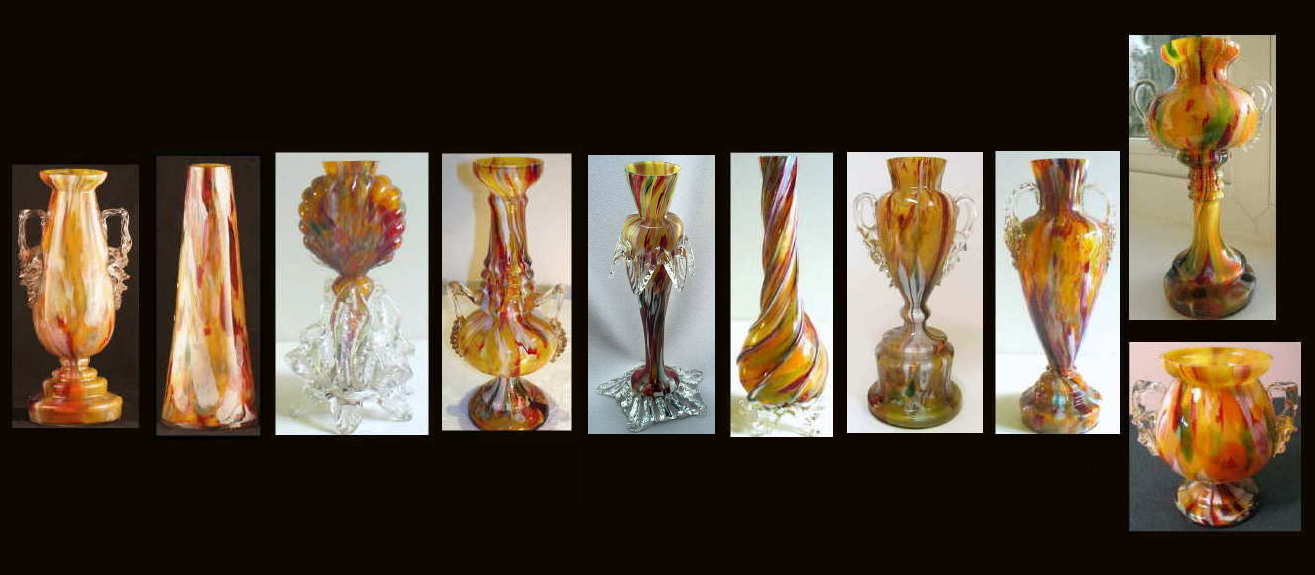
The last two pieces in the image above are pieces that allow us to now examine and strengthen a link to a different décor. Both of these shapes are unique and fairly uncommon. So let’s take a look what décor link to Welz we can strengthen through the use of these shapes.
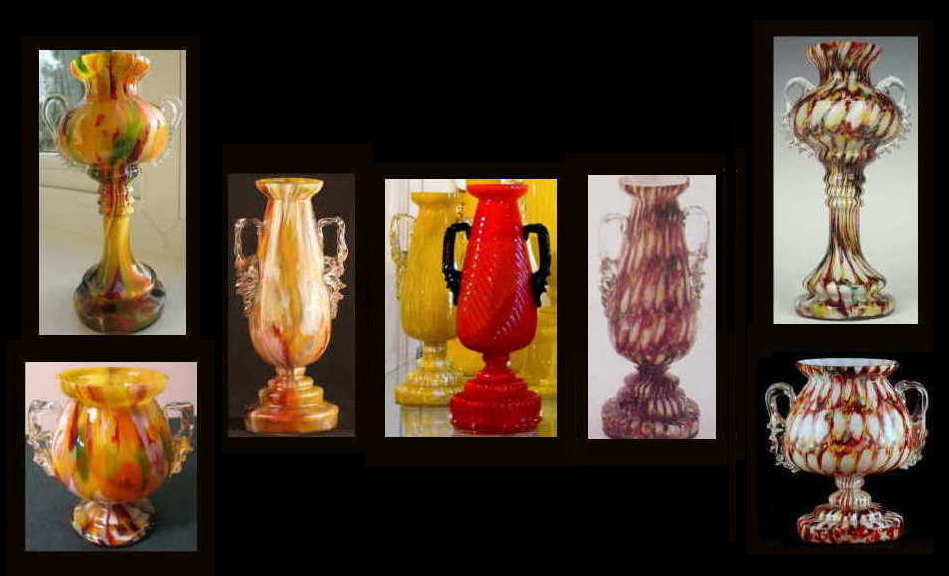
So what it would appear we have now are some fairly unique shapes and décors, both of which share a common shape linked to Welz, and reinforced by finding other unique shapes sharing the décors.
Fairly unique décors on a selection of pretty unique shapes….. What else can these distinctly unique shapes show us?
So let’s look at what the two lower pieces on the left and right ends of the above image group, two different décors on a common shape, are able to reveal.
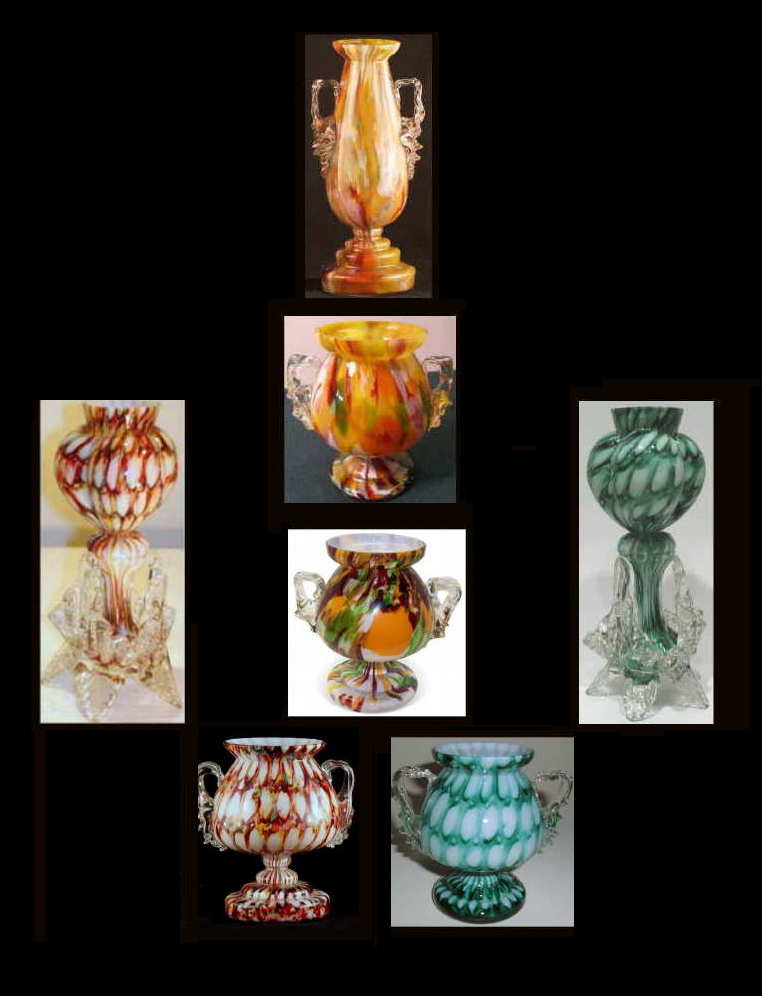
So what we now see is that this Honeycomb décor, both in Rainbow and also in green leads us to another pretty unique form. This form is one I would refer to as a Tri-lobed Heart vase. And we get to this shape using two different Variants of the same Welz décor.
The image below shows the green Honeycomb décor on a variety of different shapes also believed to be Welz. These examples appear to represent both pre and post WWI production.
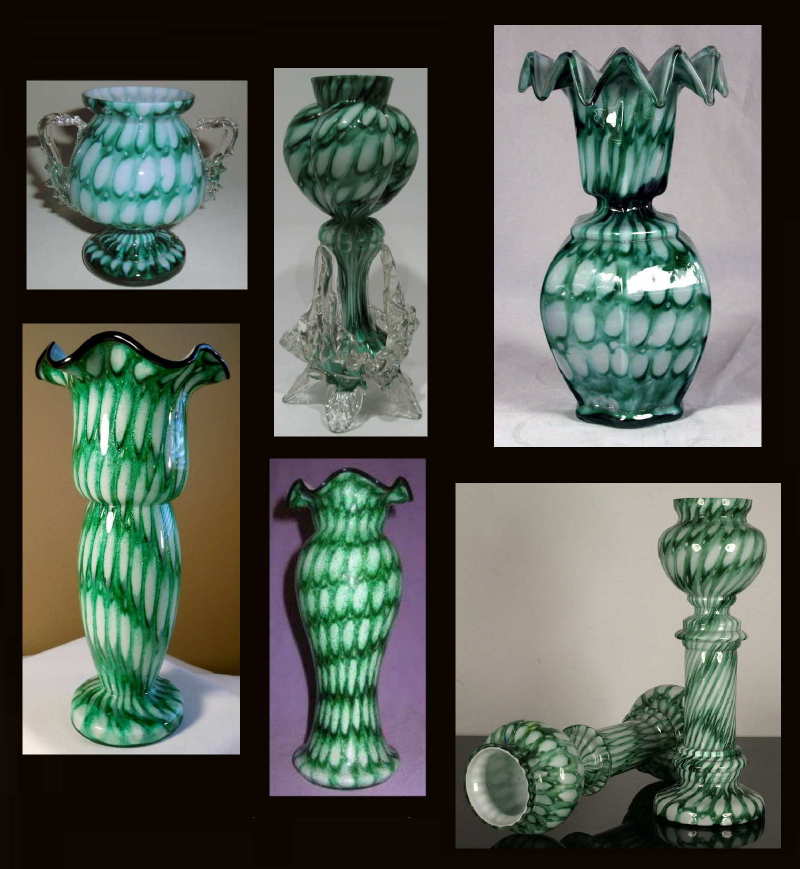
So now let’s take a look at the Tri-lobed Heart vase in the two Honeycomb décors and see what they are able to show us. Again, a unique form not seen in large quantities, and most likely produced by one house. My research says that house is Welz.
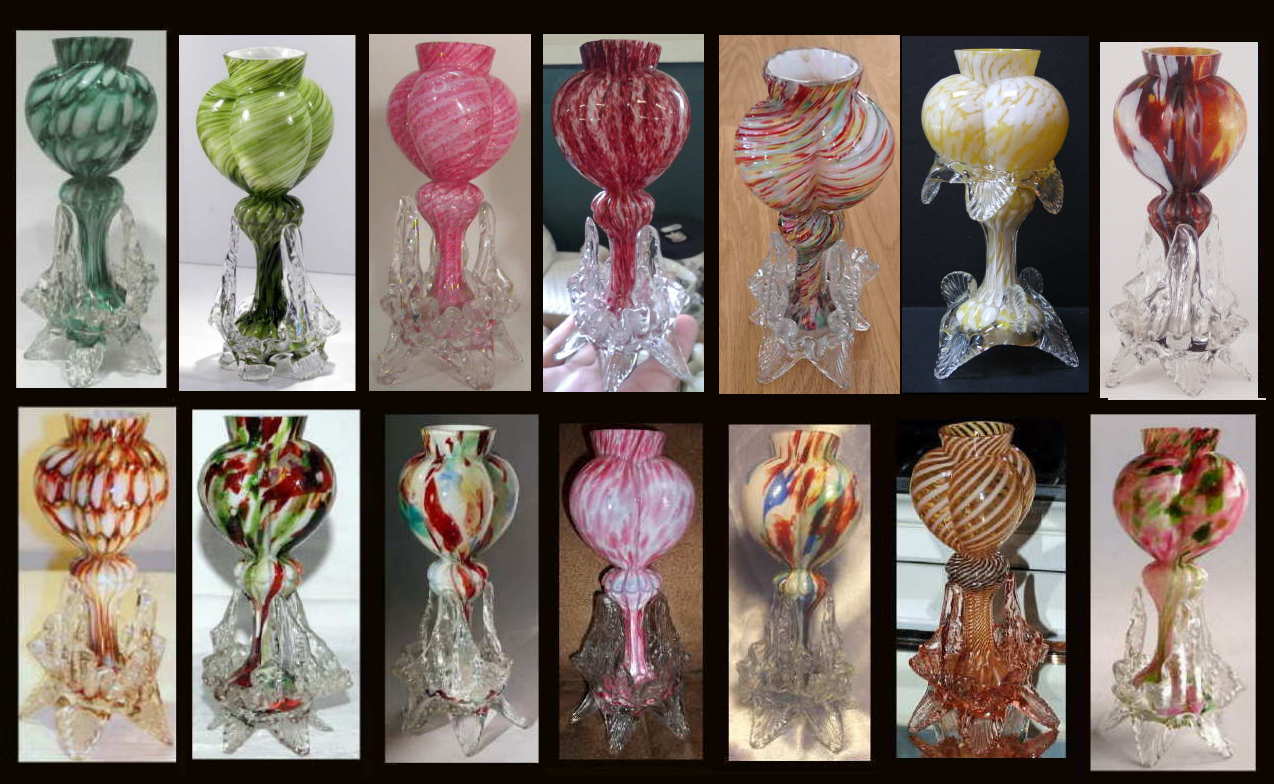
With this image we see a wide variety of similar yet distinctly different spatter style décors, I believe were produced by Welz. The last Tri-lobed Heart vases in the top and bottom row have a distinct value for comparative reasons.
First, let’s look at the Oxblood spatter décor on the top example. This décor, along with most of the others have been, in my opinion, erroneously linked to Ruckl through a series of unfounded leaps, starting with an example of a Ruckl Oxblood décor vase in a different shape, but identified through a Ruckl label on it. So let’s examine them side by side and see what differences, if any, we can find. They are shown in the image below.
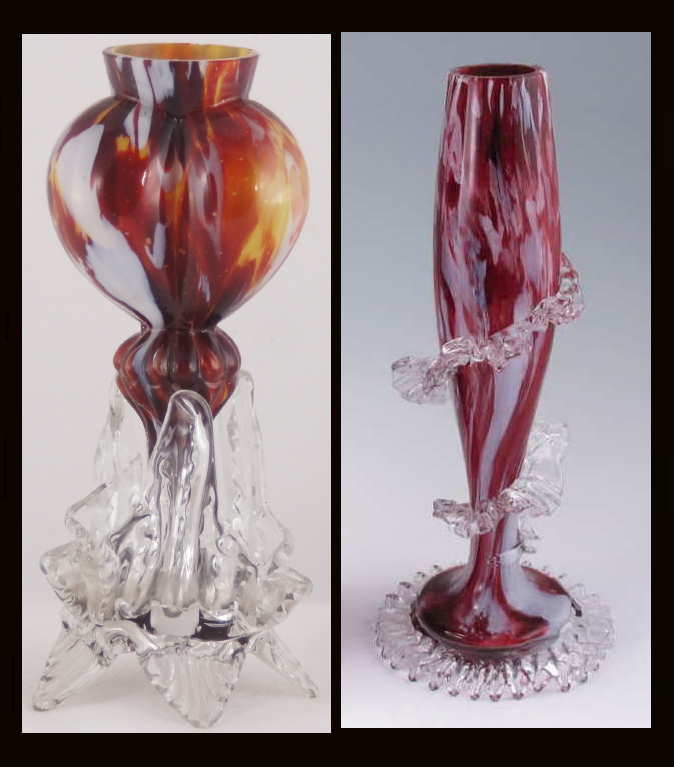
In examining the two vases seen in the above image we can see that there is a difference in the Oxblood color. But that could simply be a difference in lighting when the image was taken. We also notice that the Tri-lobed Heart vase appears to be Oxblood with white, and the Ruckl example appears to be grayer, but again this could be a difference in lighting or cameras. One very obvious difference that we see here is that the interior color of the two is completely different.
Where the Ruckl example appears to have a kind of Raspberry interior, the Welz example of this décor has an internal color which is a kind of an orange/yellow. It is in fact, the same interior color as seen on the interior of the spatter vase described earlier in the article. This is a glass which will glow orange under UV light, indicating the use of Cadmium as a colorant. Is this colorant unique to Welz? Likely not. Is Oxblood Spatter unique to Welz? Certainly not, and the picture above shows that at a minimum, both Ruckl and Welz made a version of the décor. I suspect others may have also.
What we do learn from these two examples though, is that a quick series of attributions based solely on a fairly indistinct décor, especially without examining and taking note of all the details of the vase, can easily lead us to inaccurate attributions.
The combination of white, pink, and green aventurine (mica), as seen in the Tri-lobed heart vase group above is a décor mixture also found on a variety of other shapes which have been linked to Welz interwar production, and to the ribbed trophy. In the interwar examples they used the color combination in a different manner appropriate for more modern appearing product. The image below shows additional later examples of how they “reinvented” this color combination to have a little more modernist feel. Where the Heart vase is most likely pre WWI production, the pieces shown below are all known to have been produced between 1918 and the mid 1930’s. Thus far this décor appears to be a marker for Welz production.
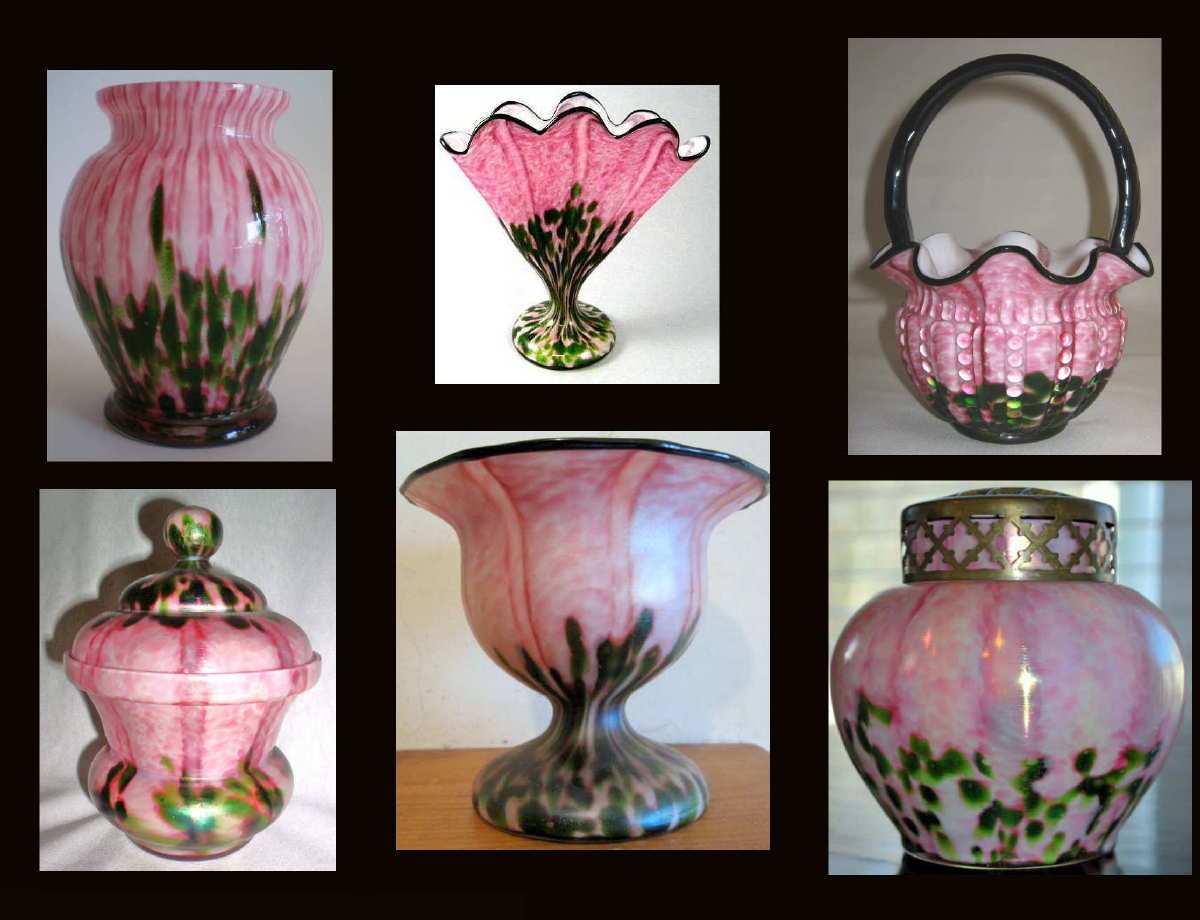
On To The Museum In Navy Bor
Now let’s examine a different form, from a different Museum exhibit. This example is from a display in the Navy Bor museum, and is on display there as a Welz vase. I apologize for the image quality, but it was the best that was made available to me.
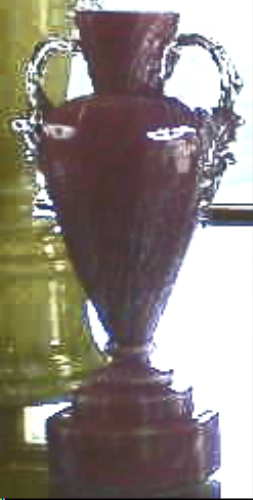
Although this is also a trophy vase, there are two important differences which we can note on this piece. The first difference is that it presents a new variant of the variegated décor, in that we now see an example in pink and white. This pink and white variant is also seen on some Welz ribbed tri-ball footed vases I will cover in a different article. The second important observation, is although it is a trophy vase, it represents a different shape with some unique characteristics. These are an octagonal base and body. Again we have an uncommon shape we can use as a possible link to other décors for Welz.
So let’s see what a study of this shape has revealed. A couple of other examples in the same form are shown in the image below.
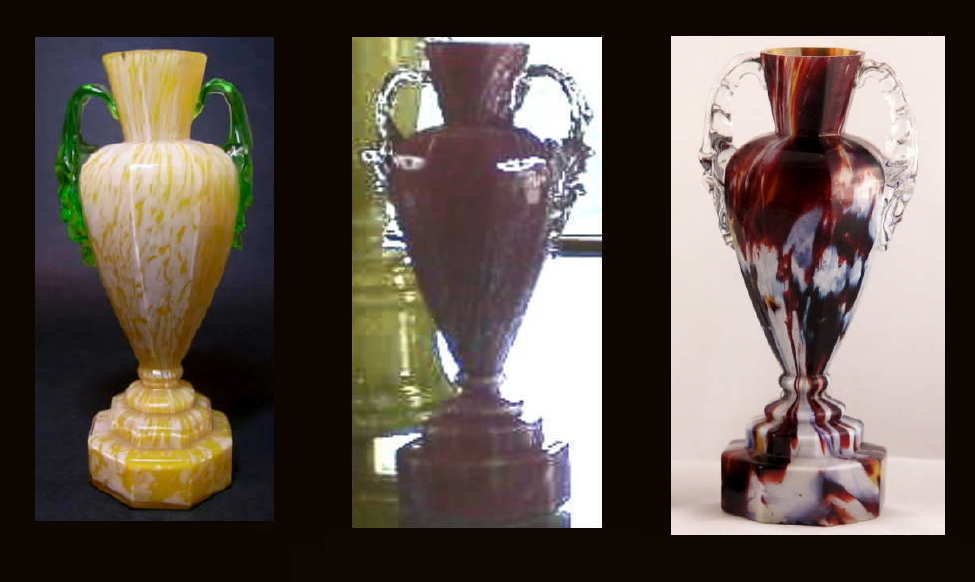
- We confirm again, through another unique shape, that the Yellow Variegated décor is found on yet another shape we can link to Welz.
- We have another quite solid link of the Oxblood Spatter décor to Welz though this shape.
- This example, as with the Tri-lobed Heart example in the Oxblood décor, has the same Cadmium based interior color. We see another example which differentiates the décor by Welz from the labeled Ruckl example of a similar, but different décor.
Another important factor here is that we can now take two separate paths starting with museum examples and link the Oxblood décor and several shapes to Welz production. The following image shows what I believe are Welz shapes in their version of the Oxblood spatter décor. All exhibit the same interior color, and the shapes can be traced, through definitive décors traits and/or shapes, to Museum displays of known Welz production. In the lower examples, the interior image is of the example to the far right, a new shape now linked through a unique décor, paying attention to both the outside and inside glass.
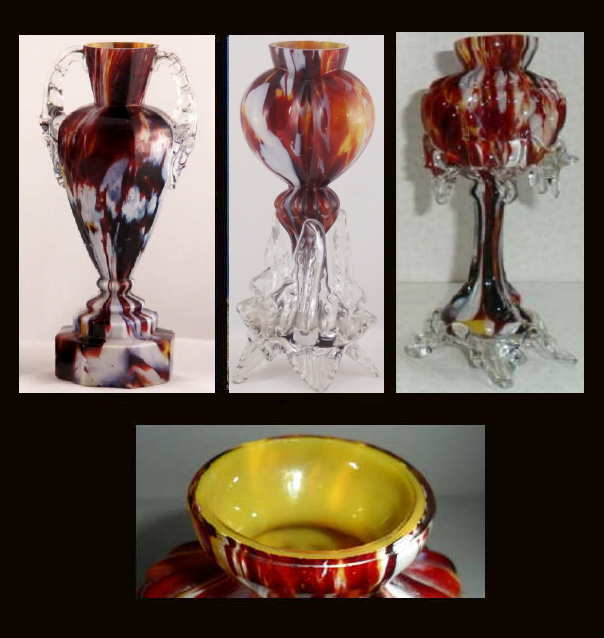
So let’s take a quick look at quite similar shapes and the potential issues that can result
if we do not pay very close attention to even the smallest details.
In the following image we can look at three vases, one identified as a Ruckl example by the label on it. The other two identified as Welz through both the green and harlequin Honeycomb décors.
A quick glance at these examples may tempt the untrained eye to believe that the three examples are the same, same shape, same winding rigaree, and same crimped foot. A close examination of these three pieces is obviously in order. Let's see what a careful examination will reveal. The examples show here are two different heights, but for the sake of easy shape comparison are shown as equal size. In matters of shape, since glass houses made the same shape in multiple sizes, size is not really as issue for the purpose of detailed shape comparisons. As an example, a ball is sphere shaped regardless of whether it is 1 inch in diameter or 1 foot indiameter. The size may change, but the basic shape does not. The purpose of this comparison is to become aware of shape differences, and not size differences, as those are really quite obvious to anyone.
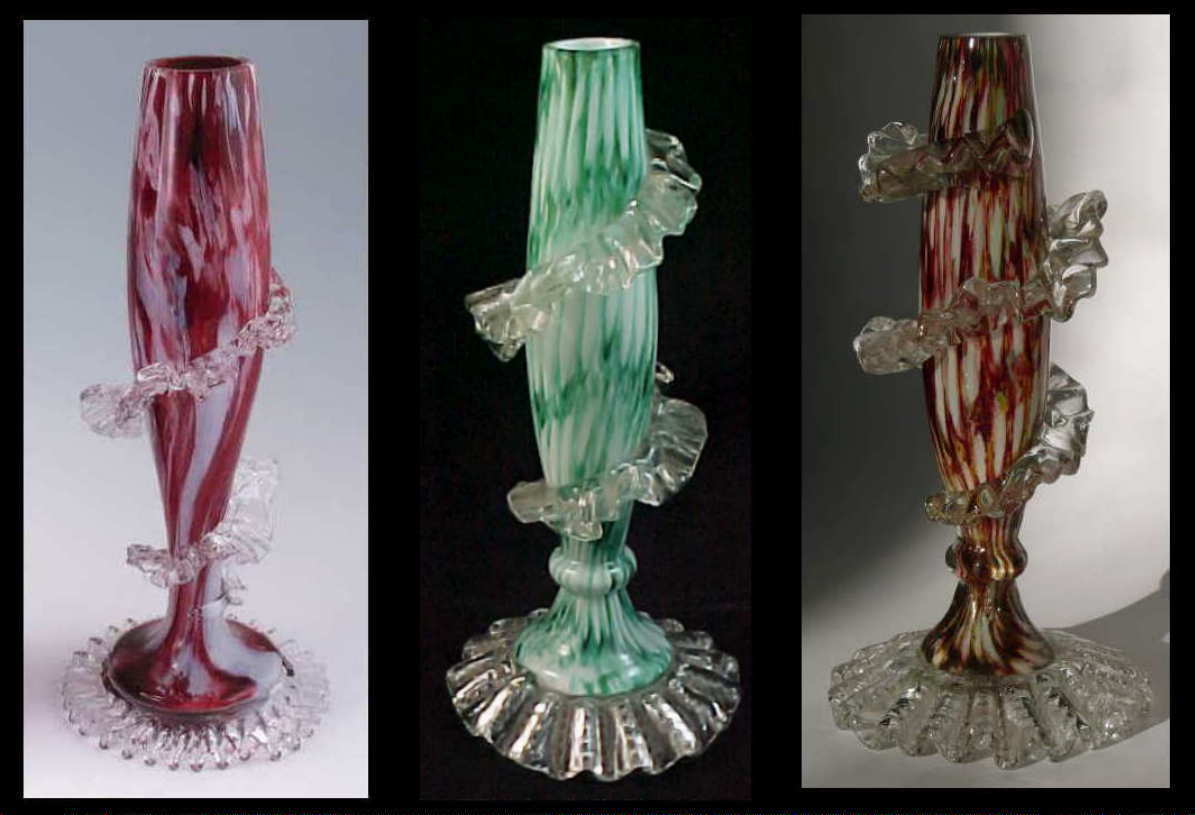
In the above image the left vase is a Ruckl example, and the other 2 examples are Welz, as evidenced by the distinct Honeycomb décors we have previously traced to their production.
So what differences do we see which would be important to note?
- The Welz examples appear to be thinner at the mouth of the vase.
- The applied rigaree appears to be “heavier” than the Ruckl example, although they do appear to be the same as each other. This is interesting in that both Welz examples appear similar to each other.
- The Welz examples appear to have a protruding ring just above the foot.
- Although these examples are different heights, the basic shapes would remain the same, if they are the same shape from the same house.
So, although a quick glance at these shapes would lead one to think they were all the same, we can determine through careful observation that they are in fact what is referred to on this website as a design shift. Two different companies making a similar, yet different shaped product, that at the time was likely selling well in specific markets.
So what can we reasonably deduce from all of this?
We have a fairly clear series of unique décor and shape links which definitely indicate that Welz was the company that produced these products. Do we think they were the only company? Likely not. It is certainly possible that future research will reveal links to other companies for similar styles of product. Until we can link these products using similar processes, we can only speculate as to what other companies, if any, produced them.
Welz production was imported into the United States, United Kingdom and Australia as early as 1885, and likely earlier. This is verified in a set of U.S. records regarding a U.S. customs dispute. We see a large amount of this style of production in the U.K., and less in the U.S., indicating that this line of product was most likely designed and produced with the U.K. market as a target. Indeed, much of what we now know to be of Czech origin, is commonly ID’d as Stourbridge production.
Do I believe Welz made a wide variety of these types of products? Yes I do, but at this point the links to many of these examples are just not strong enough to allow me to publish them as my findings.
.
.
.